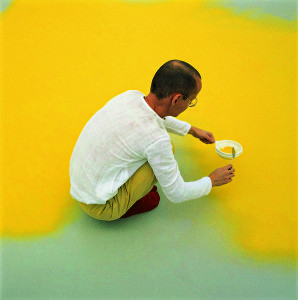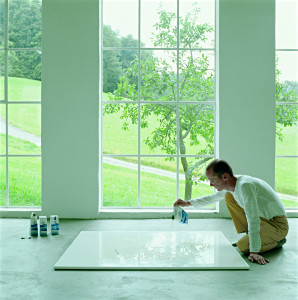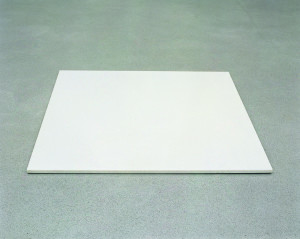Let us start from one admitted fact: if prayer, meditation, and contemplation were once taken for granted as central realities in human life everywhere, they are so no longer. They are regarded, even by believers, as somehow marginal and secondary: what counts is getting things done.
————-—Thomas Merton, from Contemplation in a World of Action
AS THOMAS MERTON OBSERVED, the contemplative life has fallen out of fashion these days. We may give lip service to the idea of stillness, but we do precious little to cultivate it. A person who refuses to make efficient use of time, who is not practical, who does not actively pursue some concrete goal, is somehow disturbing to the modern psyche.
One such iconoclast is the installation artist Wolfgang Laib. First of all, he is slow. Deliberately slow. He regularly spends entire summers in fields near his home in the Black Forest filling small jars with pollen. He’ll devote long winter months to sanding a depression into a thin piece of marble. Within the fast-paced, achievement-minded art world, his methods seem more than a little eccentric, and to the modern view of time, they are almost perversely meticulous. A pragmatist might suggest a team of assistants collecting barrels of pollen, power tools for sanding, and installations in greater numbers and size. But such mass-produced works, profitable as they might be, would no longer belong to Wolfgang Laib. It is integral to his projects that a single person completes every task. A three-inch pile of pollen on a museum floor—when we understand the lengths taken to collect it—speaks of intense care, love, and devotion. This humbling revelation would not be possible if the pollen were harvested by machines, or even by a team of assistants.
Wolfgang Laib’s work resists labels. It includes elements of performance art, photography, and conceptual art. It also exhibits the influence of Buddhism, Jainism, and Christianity. At the point of overlap among multiple categories, Laib finds a unique voice. Using exquisitely simple, everyday materials like milk, rice, and pollen, he manages to create a viewer experience that is new.
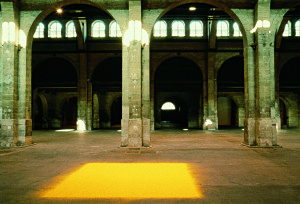
PLATE 1. Wolfgang Laib. Pollen from Hazelnut, 1986. Pollen. 126 x 142 inches. Installation: capc Musée d’Art Contemporain, Bordeaux. All photos by Wolfgang Laib unless otherwise noted. All images copyright of the artist and courtesy of the Sean Kelly Gallery, New York.
Pure pollen forms a glowing sheet of yellow pigment on a stone floor [see Plates 1 and 2]. Visitors hold their breath, partly for fear of disturbing the powdery veil, partly out of an intuitive sense of wonder. The pollen squares make no direct allusion to landscape; one is not transported to the grove where Laib collected it, but instead one is left with a tangible meditation upon light, color, and smell. The materials in their purest form become cryptic metaphors, intangible and ephemeral. Though his work is typically installed in galleries and museums, Laib has chosen at times to install it beneath the vaulted ceilings of European cathedrals. There it projects a reverent stillness that resonates in the ancient sacred spaces.
Having spent his career investigating only a handful of forms, Laib is hardly a prolific innovator. For thirty years he has worked and reworked only a few series, exploring subtle variations on a few chosen themes. This kind of long-term dedication is far too rare in the present art community, where artists can garner easy public affirmation by a proliferation of one-offs, each looking as if it had been made by a different person. Meanwhile, Laib continues to make the same milkstones with which he began his career in 1975. Over months, he’ll painstakingly sand a thin slab of Macedonian marble, creating a slight concavity over the entire surface. When the slab is finished, he carefully fills the cavity with milk [see Plate 3]. Held by surface tension, the milk covers the entire slab without spilling over the edges, creating a clean, geometric shape with a reflective surface [see Plate 4]. The resulting object is something entirely new: a piece of marble with properties never before seen in marble. The choice of materials is central. The durable stone, with its venerable place in the history in art, is juxtaposed with the cloudy, perishable, nourishing liquid. The milk can only sit upon the stone for a day or two before it begins to spoil, and so museum staff are asked to change it regularly during exhibitions. We typically think of marble sculpture as the ultimate in permanence, but it is their ephemeral nature that makes Laib’s milkstones so hauntingly beautiful.
His unusual process forces one to ask: Which part is the art? The marble without the milk is not the complete work, but neither is any given quantity of milk a permanent part of the piece. Is the art therefore in the act, the first pouring of milk by the artist? Or perhaps in the slow repetitive sanding of the marble? Maybe the finished milkstone itself is merely a record of the event, like photo documentation of performance art. These are the questions that get at the nature of Laib’s sculptures.
Pollen entered into the artist’s repertoire in 1977, and has become one of his signature forms. He uses varieties that occur naturally near his home—pine, hazelnut, and dandelion, among others. Each plant has its own life cycle, and certain species only bloom for a short time each year, and not always predictably. At the right time, the fine, powdery substance is collected by hand and stored in jars. A season may yield two jars of one type and a mere half jar of another. In most of his pollen installations, a single type of pollen (Laib doesn’t mix varieties) is sifted onto the floor of a gallery or church. Upon entering the room, one is immersed in a large field of intense primary yellow—and in the smell. The edges of the forms are slightly diffuse, and most art-educated viewers quickly make associations with the color fields of Mark Rothko. While Rothko’s paintings, like Laib’s work, are about immersion and depth of field, Laib creates an intensity and purity of reflected light that is unique. Laib’s pigments have not been diluted with oil or layered with other colors. The pollen forms a pure sheet of pigment.
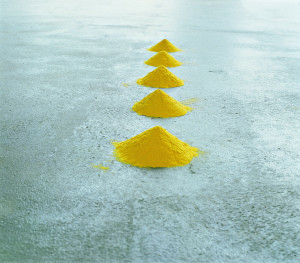
PLATE 5. Wolfgang Laib. The Five Mountains Not to Climb On, 1999. Pollen from hazelnut. 2 ¾ inches high. Installation: artist’s studio.
The floor installations are always temporary, but they still exist as art objects even when stored away. After each exhibition, the pollen is collected, separated from the accumulated dust, and returned to its glass jars. These jars have been exhibited by Laib as well, sitting on shelves or windowsills within galleries. A filled jar speaks of time spent collecting the material. Laib also sometimes arranges pollen in minute piles. In The Five Mountains Not to Climb On [see Plates 5 and 6], five cones of pollen form a perfect row. Again the artist is dealing with simple geometric forms—triangular cones in a straight line. In this minimal visual statement, the cones can refer to mountains, temples, or offerings. The way these tiny, precious accumulations can fill a vaulted hall with their immense presence is hard to believe until experienced firsthand.
It’s difficult to talk about Laib’s work outside of direct, sensory experience of it. The “imaginary museum” of art history (a term coined by André Malraux) often coaxes people into believing that once they’ve seen a reproduction of a work of art, they understand it just as well as if they’d seen it in person. After taking a course in Renaissance art or reading a book on Rembrandt, it’s tempting to believe that you’ve seen all there is to see. With sculpture, we’re somewhat less likely to leap to this conclusion than with two-dimensional art, and, for better or for worse, we’re even less likely to make such an assumption about Laib’s installations. They’re not photogenic. Though overwhelmingly beautiful in person, on the page they can seem chilly or difficult. Photos of solitary milkstones or simple yellow squares can be not only unflattering, but misleading.
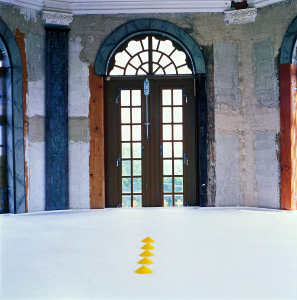
PLATE 6. Wolfgang Laib. The Five Mountains Not to Climb On, 1999. Pollen from hazelnut. 2 ¾ inches high. Installation: Schloss Belvedere, Weimar, 1990.
Laib realized early in his career that documenting his work would pose a problem. He chose to photograph everything himself in order to retain complete control—and the photos have their own beauty. Among the most powerful are those he’s taken of himself installing the work (he sets up the shots before moving in front of the camera). These process photos give us permission to witness the ceremony of creation. By making the private act public, the photographs offer viewers a new way to understand the work. The action shots also offer a sense of scale that’s missing otherwise.
Andy Goldsworthy, another artist whose work must be transmitted through photos that are not, of themselves, the art, offers a notable foil. Goldsworthy collects natural objects like rocks, leaves, and twigs to make fleeting sculptures out in the wild, which he documents with a camera. Unlike Laib’s, his images are incredibly photogenic, and almost seem best viewed that way. With the exception of a few large installations, a viewer can rarely witness a Goldsworthy piece in person. The artist usually creates work on solitary trips out into the country.
By contrast, Laib’s photos function as pure record; they may work as tools for understanding the piece better, but they are not likely to supplant the object. A reproduction can allow us to imagine a row of small pollen mountains, perhaps even to feel the beginning of a sense of their fragility and the care taken in their construction. But imagine standing next to them, walking around them slowly and carefully so as not to disturb them. The cavernous room is completely filled by the presence of these five small piles. That experience is the art, and it’s impossible to convey through a photo in a book or a slide in a classroom.
Laib’s materials also set him apart. For some artists, the choice of medium is more or less a neutral decision. Deciding to paint in oil or cast in bronze hardly draws extra attention. When an artist selects sifted pollen or poured milk, however, the work is charged with special meaning before he begins. Unlike Goldsworthy, who makes his work out in the field, Laib takes natural materials indoors and makes art there. By isolating his materials in new settings, Laib reduces them to their purest essence. Hazelnut pollen becomes a reflection upon light and color; milk becomes a meditation upon sustenance. This approach to materials brings a ready comparison to another twentieth-century German artist, perhaps the most famous, Joseph Beuys.
Beuys’ conceptual artwork draws inspiration from a history of northern European art that incorporates mysticism and nature. Whether he was being locked inside a New York gallery with a wild coyote, covering himself with gold leaf to explain art to a dead hare, or simply lecturing to universities across the globe, Beuys helped redefine art in the sixties and seventies. Deliberate selection of materials is an obvious parallel between the two German artists. Beuys chose gold leaf and lead for their connotations with alchemy, and fat, honey, and felt, among other things, for their associations with healing. When Beuys strapped a piece of lead to his foot or wrapped a piano in felt, the materials added a special significance to the performance, even if the ultimate meaning was sometimes hard to decipher. Beuys, like Laib, preferred materials in their purest possible form. He used only raw felt and unadulterated honey, lead, and fat.
Beuys also constructed an elaborate personal mythology, a narrative that can help unlock his otherwise enigmatic performance pieces. It includes, for example, being shot down during the Second World War and rescued by Tatar nomads. Beuys’ sense of spectacular self-referential drama is one of the significant differences between the two artists. Laib has his own life story, and knowing it can help in understanding his work, but he keeps his biography off center stage.
Laib was raised in southern Germany, and his family took frequent trips abroad, including to Turkey and India. He studied medicine, completed a doctoral thesis on the purity of drinking water in India, then chose not to practice medicine but to pursue a career in art instead. He, his wife, children, and parents now all live in the same rural house in which he was born. They sit, eat, and sleep on mats instead of conventional furniture. Far from the art capitals of New York, Paris, or Berlin, they live a plain, secluded, almost ascetic life.
Laib has always been attracted to ascetic practice. After his first exhibition in New York, in 1979, he rented a loft there for a few winter months. The only furnishings were a six-inch portrait of Saint Francis of Assisi, a large pollen work, and a cloth mat. In interviews, he readily admits to an interest in the monastic traditions of both east and west. He reads Buddhist philosophy, the teachings of Saint Francis, and the Sufi mystic Rumi. It’s not difficult to see the influence of the monastic traditions in his work; there’s a pervasive sense of reverence and contemplation, though Laib avoids titles or overt symbols that could link his work definitively to any one religion.
To some, Laib’s austere family life might seem a little too perfectly matched to his art, even a little calculated, but his extraordinarily painstaking working methods seem to indicate that his monk-like ways are genuine. Certainly his public persona has little to do with the media-driven personalities of artists like Joseph Beuys or Andy Warhol. A Beuys sculpture has one definitive interpretation, and that is the one Beuys says it has. Beuys’ performances and sculpture speak of a single narrative, Beuys’ personal mythology; Laib’s relate to many narratives without ever choosing one. Felt or fat in a Beuys piece can only ever mean what Beuys says it means. Joseph Beuys performed his art for the public, lecturing along with it so that people could learn about his opinions in minute detail. The pollen or milk in a Laib piece comes without an explanation. Laib performs his art privately, quietly, repetitively, inviting the viewer in only via photographs, with no words. The viewer is merely presented with the materials in their purest form and asked to contemplate them.
At first glance, it seems natural to classify Laib as a minimalist, but this would be a mistake. True, his work recalls artists like Carl Andre, Donald Judd, and Robert Morris. A viewer enters a gallery to find quiet geometric sculptures that reference nothing but their own “specific forms,” as minimalists say. Both a milkstone by Wolfgang Laib and a grid of copper plates by Carl Andre are rooted in conceptual art, a movement that holds that the idea comes first and is most important, and that the form follows in order to illustrate that idea to the viewer. Like most modern sculpture, minimalism places works directly upon the floor, rather than exalting it on a platform or pedestal, and Laib does the same. This may seem like a small thing, but it goes to the heart of how an artist sees his work. Placing work on the floor reminds everyone that the object is nothing more than what they see.
In its execution, however, Laib’s work strays far from minimalist ideology. A key difference can be found in his approach to the actual fabrication of the art. Minimalist sculpture deals with an intellectual investigation of space. It asks questions about how the work, viewer, and environment all interact and influence one another. It’s about ideas. Once the concept has been determined, the making of the artwork can easily be passed on to assistants. The role of the minimalist artist is to discover those forms that can best illustrate a doctrine, not necessarily being responsible for the object’s construction. Laib, on the other hand, insists on collecting each grain of pollen with his own hands. This approach can seem almost clinical at first, with the storing of materials in labeled jars, but the end result is a sense of awe and reverence which is palpable for viewers. His work never becomes a cold investigation of space or form; it retains something spiritual.
Judd, Andre, and other true minimalists use convenient, inexpensive materials. They celebrate plywood, concrete, steel, and aluminum, materials that come from the realm of mass fabrication and are free from the connotative baggage of classical media like bronze or marble. Against this backdrop, when Laib chooses to make sculpture out of pollen, this is more than a simple intellectual exercise. Since the pollen takes so long to collect, this is a choice with consequences for the artist. Laib invests long months in each piece, working alone. He doesn’t allow others to complete the idea for him. This painstaking process transforms the art object. Though the milkstones and pollen squares are still based in a concept, the time investment makes them meaningful as objects, not merely as illustrations.
This constitutional difference between Laib and most minimal art comes out in viewers’ reactions. A cavernous room that houses miniscule works composed of pollen is arresting to more than just the intellect. It demands thoughtful reflection and meditation. As viewers enter and exit the installation, rarely can a whisper be heard, even from those who know nothing of the artist. People respond with a deep stirring of awe. It’s similar to the reaction people have to a James Turrell skyspace, where the sky is reframed through a hole in the ceiling. No one dares break the stillness. There’s no sign telling people to be quiet; the reaction occurs naturally. Both Turrell and Laib make it difficult to deconstruct their intent, and in the face of ambiguity, viewers are forced to create their own interpretations. More often than not, this search leads them into a contemplative state. The art is not simply an object or form, but an interaction with the audience. Laib, like Turrell, creates a situation in which we are forced to slow down.
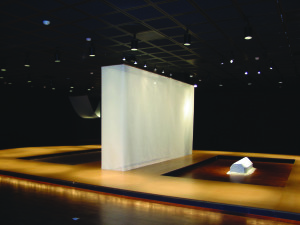
PLATE 7. Wolfgang Laib and Hirokazu Kosaka. From the Verandah: Art, Buddhism, Presence, 2003-04. An exhibition at the Fowler Museum at UCLA. Photo: Lynne Brodhead Clark.
In 2003, Laib participated in an exhibition at the Fowler Museum at UCLA titled From the Verandah: Art, Buddhism, Presence. The show paired Laib with Japanese sculptor Hirokazu Kosaka, and was intended to create a dialogue among art, viewers, and environment. Michael Rotondi, the architect who helped design the collaborative piece, explains that the goal was to create an exhibition that needed to be experienced in person. Viewers were asked to approach the art in a meditative state, removing their shoes before stepping onto the verandah, a smooth, slightly raised rectangular wooden walkway that framed two square depressions in which Kosaka’s and Laib’s pieces were placed [see Plate 7]. In shape and design, the depressions evoke Zen rock gardens. Viewers are invited to sit on prayer mats on the verandah and contemplate Laib and Kosaka’s pieces, while an amplified audio recording of falling snow plays in the background, lending a barely perceptible wash of white noise. Everything about the scene forces people to slow down. The environment offers a welcome contrast with art-culture norms, where most viewers spend less that a few seconds with each piece.
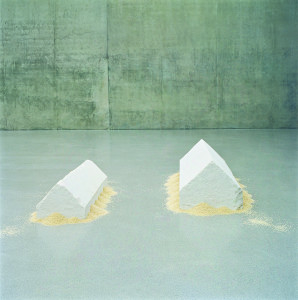
PLATE 8. Wolfgang Laib. Rice House, 1998-99. Marble and rice. 17 ¾ x 16 ½ x 49 ½ inches. Installation: Kunsthaus Bregenz, 1999. Photo: Markus Tretter.
In Laib’s “garden” he placed one of his rice houses—part of a series of works that includes aspects of both the milkstones and pollen mountains [see Plate 8]. The house is a block of white marble roughly hewn into a long, rectangular shape with a peaked roof. The series includes houses of various sizes, always with the same simplified, geometric form. In interviews, Laib has mentioned that it is deliberately reminiscent of Muslim tombs or medieval reliquaries. The house is surrounded by piles of dry white rice, which bank up against its sides. (In other pieces in the series, pollen is used sparingly among the rice, but not at the Fowler exhibition.) The juxtaposition of materials works an associative transformation in the eye of the viewer: the houses no longer read as solid marble, but instead become storage houses or granaries, filled to the brim with the simplest of food staples. As in the milkstone series, where milk seems to meld with the marble and soften it, here the properties of the stone seem changed by the rice.
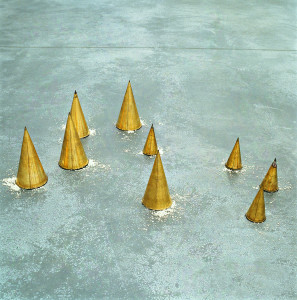
Wolfgang Laib. Untitled, or The Rice Meals for the Nine Planets, 1983. Rice, tin, and brass cones. Height: 6 ¾ to 13 ¾ inches. Installation: De Pont Foundation, Tilburg, 1993. Photo and copyright: Wolfgang Laib. Courtesy: Sean Kelly Gallery.
As with pollen, Laib has worked with rice in a variety of forms. In The Rice Meals for Nine Planets, Laib continues to reflect upon the nature of small monastic offerings [see front cover]. Like the marble houses, cones made from tin and brass are transformed by the scattered rice into forms full of sustenance. Within this constellation of metal cones, the rice becomes an offering. It is no longer ordinary, the way a votive candle is no longer ordinary when it is lit within a cathedral: the meaning of an object depends upon the context and intent with which it is presented.
The words and photos on these pages, though they can give you a sense of the ideas and forms Laib is working with, can only show you his building blocks, not his real accomplishments. This applies to any art in reproduction, but it’s truer of Laib’s work than most. I’m certainly not the first person to say that words are inadequate to describe contemplative experience, but it bears repeating. In other words, Laib’s work needs to be seen in person.
In a world where, as Merton observes, “what counts is getting things done,” Laib’s work asks the viewer to step outside the stream of time, to slow down and sink into a piece of art, not as mere concept, but as a sensory experience. Time spent contemplating a piece of art invites us to draw our own conclusions about it—an experience likely to stick with us much longer than reading about a work’s “meaning” in the long, bossy descriptions so often posted beside supposedly difficult work in museums and galleries. A contemplative approach to art requires more work from the viewer, to be sure, and this makes Laib’s work refreshing, not to say unique.




